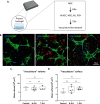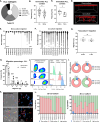A three-dimensional ex vivo model recapitulates in vivo features and drug resistance phenotypes in childhood acute lymphoblastic leukemia
- PMID: 40931046
- PMCID: PMC12634434
- DOI: 10.1038/s41375-025-02739-8
A three-dimensional ex vivo model recapitulates in vivo features and drug resistance phenotypes in childhood acute lymphoblastic leukemia
Abstract
Acute lymphoblastic leukemia (ALL) preferentially localizes in the bone marrow (BM) and displays recurrent patterns of medullary and extra-medullary involvement. Leukemic cells exploit their niche for propagation and survive selective pressure by chemotherapy in the BM microenvironment, suggesting the existence of protective mechanisms. Here, we established a three-dimensional (3D) BM mimic with human mesenchymal stromal cells and endothelial cells that resemble vasculature-like structures to explore the interdependence of leukemic cells with their microenvironment. This model recapitulates recurrent topologic differences between B-cell and T-cell precursor ALL, whereby B-ALL interacts more closely with the mesenchymal compartment. Migration versatility was found to be associated with subtype, consistent with increased motility observed in T-ALL in vivo. Single-cell RNA signatures revealed similarities to profiles from in vivo patient derived xenografts, suggesting relevant states ex vivo. Furthermore, enhanced migration, adherence and cell cycle heterogeneity was visualized in our co-culture model. Finally, drug response experiments in this 3D model confirm clinically relevant sensitivity and resistance patterns that reflect specific disease phenotypes and may provide a broader dynamic range for drug response testing.
© 2025. The Author(s).
Conflict of interest statement
Competing interests: Ectica Technologies AG, in which B.R.S. and M.E. have ownership and interests, provided the hydrogel-based cell culture plate used in this study as an in-kind contribution. The remaining others declare no conflict of interest.
Figures







References
MeSH terms
Grants and funding
- CRSII5_186271 [Deplancke][Bourquin]/Schweizerischer Nationalfonds zur Förderung der Wissenschaftlichen Forschung (Swiss National Science Foundation)
- CRSII5_186271 [Naveiras][Bourquin]/Schweizerischer Nationalfonds zur Förderung der Wissenschaftlichen Forschung (Swiss National Science Foundation)
- CRSII5_186271 [Ehrbar][Bourquin]/Schweizerischer Nationalfonds zur Förderung der Wissenschaftlichen Forschung (Swiss National Science Foundation)
- CRSII5_186271/Schweizerischer Nationalfonds zur Förderung der Wissenschaftlichen Forschung (Swiss National Science Foundation)
LinkOut - more resources
Full Text Sources

